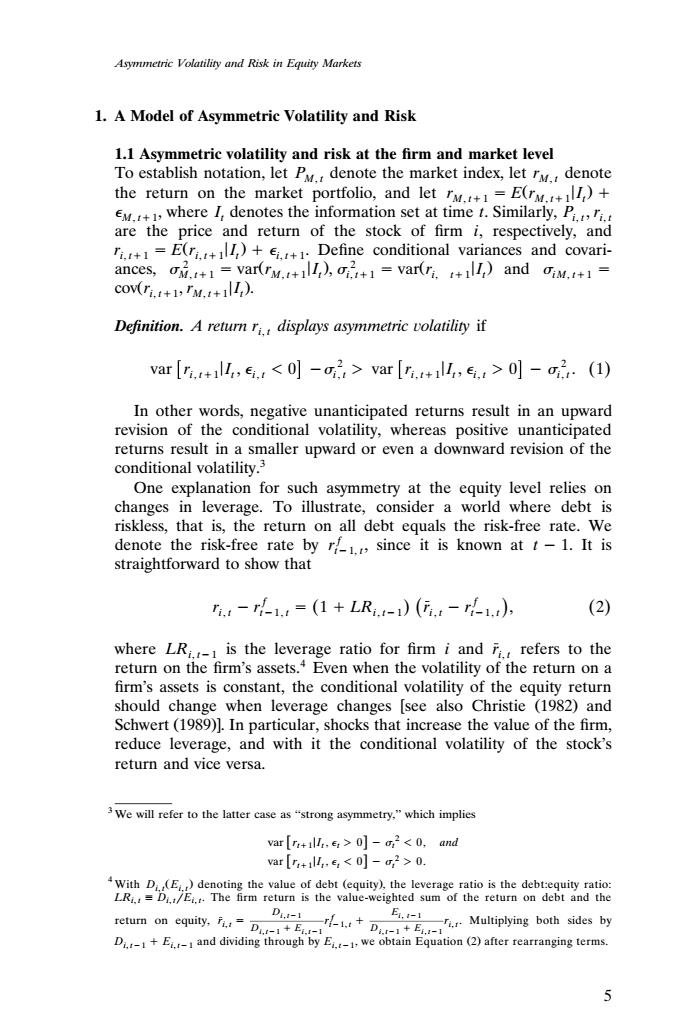正在加载图片...

Asymmetric Volatility and Risk in Equity Markets 1.A Model of Asymmetric Volatility and Risk 1.1 Asymmetric volatility and risk at the firm and market level To establish notation,let P.denote the market index,let rM.denote the return on the market portfolio,and let rM.+1=E(rM.+)+ M.,where I,denotes the information set at time t.Similarly,P are the price and return of the stock of firm i,respectively,and ri.+=E(ri.+)++Define conditional variances and covari- ances,.+1=var(rM.+),+1=var(ri.)and iM.+1= cov(r.+M.+). Definition.A return ri,displays asymmetric volatility if var[y.+ilh,∈.<0]-o2>var[y.+l山,∈.t>0]-o(1) In other words,negative unanticipated returns result in an upward revision of the conditional volatility,whereas positive unanticipated returns result in a smaller upward or even a downward revision of the conditional volatility.3 One explanation for such asymmetry at the equity level relies on changes in leverage.To illustrate,consider a world where debt is riskless,that is,the return on all debt equals the risk-free rate.We denote the risk-free rate by r1.since it is known at t-1.It is straightforward to show that .,-11=(1+LR.-)(G.-t) (2) where LRi.-1 is the leverage ratio for firm i and .refers to the return on the firm's assets.+Even when the volatility of the return on a firm's assets is constant,the conditional volatility of the equity return should change when leverage changes [see also Christie (1982)and Schwert (1989)].In particular,shocks that increase the value of the firm, reduce leverage,and with it the conditional volatility of the stock's return and vice versa. 3 We will refer to the latter case as"strong asymmetry,"which implies var [r+ill,e >0]-2<0,and var[r+il,e<0]-2>0. 4With D(E)denoting the value of debt (equity),the leverage ratio is the debt:equity ratio: LR=Di./E..The firm return is the value-weighted sum of the return on debt and the DuD retum on equity,D+E E.Multiplying both sides by Di1+E-and dividing through by E.-1,we obtain Equation (2)after rearranging terms. 5Asymmetric Volatility and Risk in Equity Markets 1. A Model of Asymmetric Volatility and Risk 1.1 Asymmetric volatility and risk at the firm and market level To establish notation, let PM denote the market index, let r denote , t M, t the return on the market portfolio, and let rM, t1 Er I Ž M, t1 t . M , where I denotes the information set at time t. Similarly, P , r , t1 t i, t i, t are the price and return of the stock of firm i, respectively, and r Er I Ž . . Define conditional variances and covari- i, t1 i, t1 t i, t1 2 Ž . 2 ances, M, t1 var r I M, t1 t i , , t1 varŽr I i, t1 t iM . and , t1 covŽr , r I .. i, t1 M, t1 t Definition. A return r displays asymmetric olatility if i, t 2 2 var r I , 0 var r I , 0 . 1Ž . i, t1 t i, t i, t i, t1 t i, t i, t In other words, negative unanticipated returns result in an upward revision of the conditional volatility, whereas positive unanticipated returns result in a smaller upward or even a downward revision of the conditional volatility.3 One explanation for such asymmetry at the equity level relies on changes in leverage. To illustrate, consider a world where debt is riskless, that is, the return on all debt equals the risk-free rate. We denote the risk-free rate by r f , since it is known at t 1. It is t1, t straightforward to show that f f ri, t t r 1, t i Ž . Ž. 1 LR r , t1 Ž . i, t t r 1, t , 2 where LR is the leverage ratio for firm i and r refers to the i, t1 i, t return on the firm’s assets.4 Even when the volatility of the return on a firm’s assets is constant, the conditional volatility of the equity return should change when leverage changes see also Christie 1982 and Ž . Schwert 1989 . In particular, shocks that increase the value of the firm, Ž . reduce leverage, and with it the conditional volatility of the stock’s return and vice versa. 3 We will refer to the latter case as ‘‘strong asymmetry,’’ which implies 2 var r I t1 tt t , 0 0, and 2 var r I , 0 0. t1 tt t 4 With D EŽ. Ž . denoting the value of debt equity , the leverage ratio is the debt:equity ratio: i, t i, t LR D E . The firm return is the value-weighted sum of the return on debt and the i, t i, t i, t D E i, t1 i, t1 f return on equity, r r r . Multiplying both sides by i, t t1, t i, t Di, t1 E D i, t1 i, t1 Ei, t1 D E and dividing through by E , we obtain Equation 2 after rearranging terms. Ž . i, t1 i, t1 i, t1 5�����������������